
Originally published in The Clarinet 50/1 (December 2022).
Printed copies of The Clarinet are available for ICA members.
Music Reviews: December 2022
Steven Klimowski. Clarinet Workout, a framework for practicing. SEK Press, Revised 2022. [email protected] $30.00
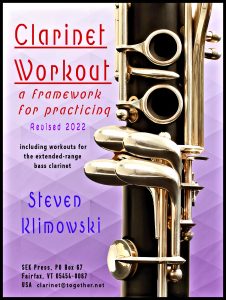 Inspired by his clarinet study with Leon Russianoff from 1970 to 1977 and reflecting his decades of teaching and working as a professional clarinetist, Steven Klimowski’s Clarinet Workout could also be titled “A Practical Method to Develop the Technique and Method to Play Anything!” At least, that is my impression of the careful pedagogy Klimowski shares in his five-page introduction, with detailed suggestions of how to use the 71 pages of exercises utilizing every major and minor key (harmonic minor). The student is well-advised to strongly consider Klimowski’s “routines,” as they importantly teach how to practice any technical challenge. With equal parts awareness training and the concept of “divide and conquer,” Clarinet Workout uses a combination of exercises most closely aligned with the J.B. Albert 24 Scales and Exercises but also includes elements from Baermann’s Complete Method, Third Division, with the inclusion of exercises on dominant seventh chords and fully diminished chords.
Inspired by his clarinet study with Leon Russianoff from 1970 to 1977 and reflecting his decades of teaching and working as a professional clarinetist, Steven Klimowski’s Clarinet Workout could also be titled “A Practical Method to Develop the Technique and Method to Play Anything!” At least, that is my impression of the careful pedagogy Klimowski shares in his five-page introduction, with detailed suggestions of how to use the 71 pages of exercises utilizing every major and minor key (harmonic minor). The student is well-advised to strongly consider Klimowski’s “routines,” as they importantly teach how to practice any technical challenge. With equal parts awareness training and the concept of “divide and conquer,” Clarinet Workout uses a combination of exercises most closely aligned with the J.B. Albert 24 Scales and Exercises but also includes elements from Baermann’s Complete Method, Third Division, with the inclusion of exercises on dominant seventh chords and fully diminished chords.
Two pages are allotted to each key in this spiral-bound book. Noteworthy is the varied approach to arpeggios where the player is not only called on to play printed exercises, but also to expand an arpeggio from the basic ascending pattern using an add-a-note style from both the bottom and top of the clarinet range, which for this book is altissimo G.
Another distinguishing feature is the inclusion of a second version of C major and minor, D-flat major and C-sharp minor, D major and minor, and E-flat major and minor for low C bass clarinets using the bass clarinet’s lowest notes. Altissimo G is the top note.
For my own students, to whom in the past I recommended the Albert book, I think this is superior due to its inclusion of dominant seventh chord patterns and the thoughtful and flexible approach to practicing and learning.
– Gregory Barrett
Maarten Ornstein. 10 Pieces of 10 for solo instruments or voice. Donemus Publishing, 2019. Commissioned by Performing Arts Fund NL. Newzik digital download €13.65, PDF €16.38, hardcopy €27.30
 The 10 pieces in this 26-page collection, mostly written in traditional Western notation, serve to expand a player’s repertoire and knowledge in the art of improvisation. These pieces are not written in a jazz idiom, even as broadly and modish as that word is sometimes used in referring to contemporary stylistic genres. Each piece is briefly explained and then followed by 10 tips that guide the student in learning to improvise. These instructions are helpful, being somewhat detailed and written in a conversational manner. Many of the pieces focus on meter and rhythm, encouraging the player to vary the regularity of a meter or use a rhythmic figure as a basis for variations of that rhythm or groove. The pieces contain minimal articulation markings. Though the author suggests memorizing the pieces, non-improvising players may find themselves striving for exactness in the memorization process. I played through every piece in the book on both clarinet and saxophone and worked through the instructions for each piece. I found that my own instincts and training on each instrument tended to guide my choices of how I varied aspects of each piece. The book is published in various transpositions. The B-flat version contains occasional challenging technical passages in the upper clarion register, suited for a more advanced player. This is a collection of pieces for a reasonably advanced player who has solid technical command of their instrument and has firmly established counting and rhythm skills. Will this collection aid in helping a player to learn to improvise? Yes, if the player works to utilize the 10 suggestions as beginning points to develop their own ideas and, as the author suggests, the player learns to trust their ears.
The 10 pieces in this 26-page collection, mostly written in traditional Western notation, serve to expand a player’s repertoire and knowledge in the art of improvisation. These pieces are not written in a jazz idiom, even as broadly and modish as that word is sometimes used in referring to contemporary stylistic genres. Each piece is briefly explained and then followed by 10 tips that guide the student in learning to improvise. These instructions are helpful, being somewhat detailed and written in a conversational manner. Many of the pieces focus on meter and rhythm, encouraging the player to vary the regularity of a meter or use a rhythmic figure as a basis for variations of that rhythm or groove. The pieces contain minimal articulation markings. Though the author suggests memorizing the pieces, non-improvising players may find themselves striving for exactness in the memorization process. I played through every piece in the book on both clarinet and saxophone and worked through the instructions for each piece. I found that my own instincts and training on each instrument tended to guide my choices of how I varied aspects of each piece. The book is published in various transpositions. The B-flat version contains occasional challenging technical passages in the upper clarion register, suited for a more advanced player. This is a collection of pieces for a reasonably advanced player who has solid technical command of their instrument and has firmly established counting and rhythm skills. Will this collection aid in helping a player to learn to improvise? Yes, if the player works to utilize the 10 suggestions as beginning points to develop their own ideas and, as the author suggests, the player learns to trust their ears.
– John Cipolla
Euday Bowman. Three Ragtimes arranged by Heinz Bethmann for clarinet and piano. Musikverlag Bruno Uetz, 2022. €15.00
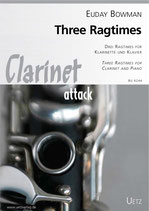 Euday Bowman wrote the most popular ragtime piece of all time, 12th Street Rag. Of interest to readers of The Clarinet, both Sidney Bechet and Benny Goodman performed it. So why not let Heinz Bethmann’s arrangements entertain you? The second rag in this collection, Black and White Rag, like the 12th Street Rag, uses a repeating three-note melodic pattern superimposed on a duple meter. This is not the syncopation of other famous ragtime pieces, but it does create shifting accents and is a welcome vehicle for improvisation. Texas Steer is the final rag in this set and uses syncopated patterns with tied 16ths over the middle of the bar, and ragtime’s ubiquitous 16th–eighth–16th figure.
Euday Bowman wrote the most popular ragtime piece of all time, 12th Street Rag. Of interest to readers of The Clarinet, both Sidney Bechet and Benny Goodman performed it. So why not let Heinz Bethmann’s arrangements entertain you? The second rag in this collection, Black and White Rag, like the 12th Street Rag, uses a repeating three-note melodic pattern superimposed on a duple meter. This is not the syncopation of other famous ragtime pieces, but it does create shifting accents and is a welcome vehicle for improvisation. Texas Steer is the final rag in this set and uses syncopated patterns with tied 16ths over the middle of the bar, and ragtime’s ubiquitous 16th–eighth–16th figure.
Broaden your repertoire, have a little fun and experience this American music that made a smooth transition to jazz. Three Ragtimes is intermediate level, with plenty of pinky work and break-crossing, and is a wonderful vehicle for subdivision and rhythm practice.
– Gregory Barrett
Allen Cohen. Sonata for Clarinet and Piano (“Journey”). Self-published, 2004. PDFs (gratis) or paper copies are available from the composer: www.allenlcohen.com
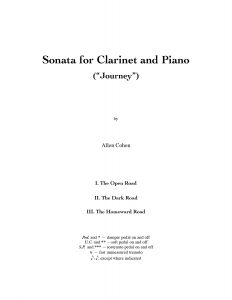 American composer Allen Cohen is professor of music at Fairleigh Dickinson University and board member of the League of Composers/International Society for Contemporary Music. His music has been played in Carnegie Hall and other venues across the US and Europe. He is the author of Howard Hanson in Theory and Practice and co-author of Writing Musical Theater. Cohen received his DMA from CUNY, where he studied with Thea Musgrave, Bruce Saylor, and David Del Tredici. He has also performed extensively as a conductor and pianist.
American composer Allen Cohen is professor of music at Fairleigh Dickinson University and board member of the League of Composers/International Society for Contemporary Music. His music has been played in Carnegie Hall and other venues across the US and Europe. He is the author of Howard Hanson in Theory and Practice and co-author of Writing Musical Theater. Cohen received his DMA from CUNY, where he studied with Thea Musgrave, Bruce Saylor, and David Del Tredici. He has also performed extensively as a conductor and pianist.
Cohen considers himself a modern American Romantic, influenced by both the art music of many centuries and the popular music of today and yesterday, with melody, energy, concision, and intensity of emotional expression being the hallmarks of his music. He has written several clarinet compositions: Skylands Idyll for clarinet solo, woodwind quintet Picnic, reed trio Walking the Cotswolds, and this sonata.
His 14½-minute Sonata is tightly unified thematically—all of the material is derived from the main theme of the first movement. The themes of the second movement are inversions of those of the first, and in the last movement these themes are further transformed and developed.
The Sonata, with frequent changes of meter, use of high register, relatively fast tempos in the first and third movements and extended techniques in the mysterious second movement, calls for professional or advanced student performers. It was premiered by clarinetist Edward Joffe with the composer at the piano at New Jersey City University in 2004. In 2019 it was performed by the Serbian clarinetist Zlatko Andrijašević, at his MM recital at the University of Priština in Kosovska Mitrovica.
According to the composer, the Sonata was inspired by the notion of a journey or quest, which can be found in countless legends and adventure stories, and even in one’s own life. The first movement, “The Open Road,” represents the blithe, light-hearted setting-out; the second movement, “The Dark Road,” the doubts and fears of the nighttime in strange wild places, or the “dark night of the soul,” and the third, “The Homeward Road,” the arduous struggle to find a home, whether that means going back or onward.
This is enjoyable and interesting music, skillfully crafted, that is worthy of practicing and performing.
– Andrija Blagojević
Paul Alan Levi. Dreaming Of…, for B-flat clarinet and piano. www.paullevi.com. $30.00
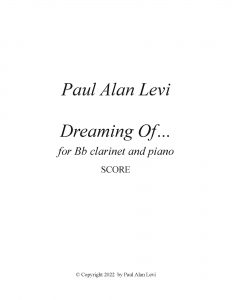 Paul Alan Levi, is an American composer born in 1941 in New York, who now resides in Washington, DC. He received his musical education from Oberlin College and the Juilliard School, where he studied composition with noted professor Vincent Persichetti and his former student, composer and jazz pianist Hall Overton. Levi has taught at the Aaron Copland School of Music, Rutgers University, Manhattan School of Music, New York University, Lehman College and Baruch College. Levi’s music has been performed in major venues in the United States (including Carnegie Hall) and Europe, and on national television.
Paul Alan Levi, is an American composer born in 1941 in New York, who now resides in Washington, DC. He received his musical education from Oberlin College and the Juilliard School, where he studied composition with noted professor Vincent Persichetti and his former student, composer and jazz pianist Hall Overton. Levi has taught at the Aaron Copland School of Music, Rutgers University, Manhattan School of Music, New York University, Lehman College and Baruch College. Levi’s music has been performed in major venues in the United States (including Carnegie Hall) and Europe, and on national television.
Levi composes in a wide variety of styles and genres. His work Dreaming Of…, for B-flat clarinet and piano (also available in a version for violin and piano) excellently represents his approach to composing. In this five-movement work, the composer, in his own words, “…tried to inhabit the stylistic worlds of five different composers and idioms.”
The composition, “written during the COVID years of 2020-2022,” starts with the lyrical, ethereal “Dreaming of Schubert,” which is followed by more contemporary sounds in the mysterious “Dreaming of Bartòk.” The third movement is the fun, playful, and joyful “Dreaming in Ragtime,” the fourth is named “Dreaming of Ravel,” while the fifth, “Dreaming in Yiddish,” is inspired by Yiddish folk music, with a long solo cadenza at the beginning and klezmer-style ending.
The composer commented that he prefers performance in that exact order, but that any other order of the movements, or the performance of only selected movements, would be acceptable to him.
Up to now, only the last movement, “Dreaming in Yiddish,” has received a public performance—it was premiered on May 9, 2022, at the YIVO Institute for Jewish Research in New York by clarinetist Moran Katz and pianist Marika Bournaki. It is hoped that the whole composition, the duration of which is approximately 20 minutes, will receive its premiere soon and numerous performances afterwards. It is fresh and pleasant and the varied styles of its movements will excite the interest of the audience.
This composition, of moderate technical requirements, can also be used for teaching purposes to introduce different musical styles to students, who can perform either the composition in its entirety or separate movements in studio classes and public concerts.
PDFs of the score and clarinet part are available for purchase from the composer.
– Andrija Blagojević
Michael Lysight. Prisme for B-flat bass clarinet and piano. Gerard Billaudot Éditeur, 2022. €12.21
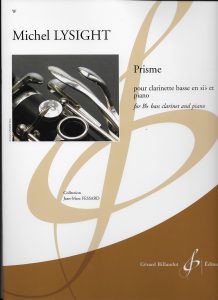 Outstanding composer Michel Lysight, of the Royal Brussels Conservatory, has written for colleague Jean-Marc Fessard a viscerally engaging and beautiful 10-minute duet for bass clarinet and piano. From the first notes the music draws one in on its journey of melody and images. In this medium-difficult work the bass clarinet plays throughout a three-octave range from lowest C to altissimo D-sharp. Most of the music is medium-paced, allowing the expressive nature of the music to breathe. For contrast (refraction through the prism?), faster sections are used with new rhythmic feels, including a very groovy syncopation. Minor and major modes are traversed, and the pleasing harmony is never astringent though there is enough bite that the music is not saccharine. From the gentle beginning to the rousing ending, Prisme is one of the best recent bass clarinet and piano pieces. It is a true duo work, and you should experience it as soon as possible. Highly recommended.
Outstanding composer Michel Lysight, of the Royal Brussels Conservatory, has written for colleague Jean-Marc Fessard a viscerally engaging and beautiful 10-minute duet for bass clarinet and piano. From the first notes the music draws one in on its journey of melody and images. In this medium-difficult work the bass clarinet plays throughout a three-octave range from lowest C to altissimo D-sharp. Most of the music is medium-paced, allowing the expressive nature of the music to breathe. For contrast (refraction through the prism?), faster sections are used with new rhythmic feels, including a very groovy syncopation. Minor and major modes are traversed, and the pleasing harmony is never astringent though there is enough bite that the music is not saccharine. From the gentle beginning to the rousing ending, Prisme is one of the best recent bass clarinet and piano pieces. It is a true duo work, and you should experience it as soon as possible. Highly recommended.
– Gregory Barrett
Amilcare Ponchielli. Paolo e Virginia, duet for violin, clarinet and piano, Op. 78. First modern edition by Francesco Ottonello. Da Vinci Edition, 2022. €26.90
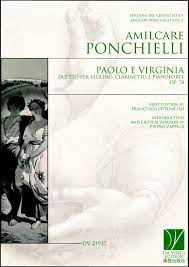 Amilcare Ponchielli (1834-1886) was a prominent Italian opera composer from the second half of the 19th century. He was active as a teacher at the Conservatory of Milan (among his most celebrated pupils were Giacomo Puccini and Pietro Mascagni) and as a band director in Cremona. His most significant compositions were his operas, such as La Gioconda, but he expressed his musical ideas in several musical genres—as represented by the enormous quantity of band music he wrote. Conducting the local band of Cremona, he got to know wind instruments very well; maybe this was the reason he dedicated to them brilliant and lovely works, almost always including clarinet.
Amilcare Ponchielli (1834-1886) was a prominent Italian opera composer from the second half of the 19th century. He was active as a teacher at the Conservatory of Milan (among his most celebrated pupils were Giacomo Puccini and Pietro Mascagni) and as a band director in Cremona. His most significant compositions were his operas, such as La Gioconda, but he expressed his musical ideas in several musical genres—as represented by the enormous quantity of band music he wrote. Conducting the local band of Cremona, he got to know wind instruments very well; maybe this was the reason he dedicated to them brilliant and lovely works, almost always including clarinet.
The Convegno (1857) for two clarinets and piano (or orchestra) is perhaps the most popular and most performed work, being a real showpiece, very suitable to impress audiences. Other works of his early period in the chamber music field are the Quartet for flute, oboe, BÌ, and EÌ clarinets and piano and Ricordanze dalla Traviata (Memories from Traviata) for flute, oboe, clarinet, and piano. A late composition, written in 1877, in comparison to the above citated works, is the duet Paolo e Virginia for violin, clarinet, and piano. With this piece we find a direct connection with the novel Paul et Virginie by Jacques-Henri Bernardin de Saint-Pierre. Lyrical and cantabile sections alternate with virtuoso passages where the violin and clarinet show off their technical abilities. The novel was also the basis of an opera of the same name by Victor Massè that premiered in Paris in 1876.
This new Da Vinci edition of Francesco Ottonello (first edition in modern times!) is very accurate in every respect. The introduction and critical remarks of Pietro Zappalà are very informative and detailed. This publication (volume 2 in their Ponchielli series) was made possible through the funding of the Centro Studi Ponchielli of Cremona. Very highly recommended, indeed!
– Luigi Magistrelli
Karol Beffa. Les Ombres Errantes trio pour clarinette en siÌ, cor et piano. Gérard Billaudot Éditeur, 2022. €31.74
 French and Swiss composer Karol Beffa has recently published his Les Ombres Errantes, which roughly translates to The Wandering Shadows. This arrangement for clarinet, horn, and piano is preceded by two others, which have their own titles: Les Ombres Qui Passent for violin, cello, and piano, and Cortége des Ombres for clarinet, viola, and piano. The piece is approximately 20 minutes in length, and consists of a fast, rhythmic second movement that contrasts with the two slow outer movements. The composer has included a foreword about his compositional method. Beffa describes the wide leaps and disparate melodic lines of the first and third movements as “almost Webernian” and emphasizes the contrast that the second movement provides.
French and Swiss composer Karol Beffa has recently published his Les Ombres Errantes, which roughly translates to The Wandering Shadows. This arrangement for clarinet, horn, and piano is preceded by two others, which have their own titles: Les Ombres Qui Passent for violin, cello, and piano, and Cortége des Ombres for clarinet, viola, and piano. The piece is approximately 20 minutes in length, and consists of a fast, rhythmic second movement that contrasts with the two slow outer movements. The composer has included a foreword about his compositional method. Beffa describes the wide leaps and disparate melodic lines of the first and third movements as “almost Webernian” and emphasizes the contrast that the second movement provides.
The clarinet part is in a comfortable range throughout, but does include many wide intervals, as well as a significant amount of flutter tonguing. The oversized parts are printed on heavy paper and are easy to read. The score is in C, and the parts for clarinet and horn include lines for both instruments, which should be helpful in keeping rehearsals efficient. The overall mood of Les Ombres Errantes shifts from lovely, flowing lines to intense weighty material and back. The distinctive style of this composition, as well as its dark, troubling tonal palate will make it a unique and intriguing addition to a recital.
– Madelyn Moore
Pavel Haas. Wind Quintet, Op. 10. Edited by Robert Simon for Bärenreiter Urtext, 2022. Publication supported by the Terezin Composers’ Institute. Study score €24.95, parts €30.95
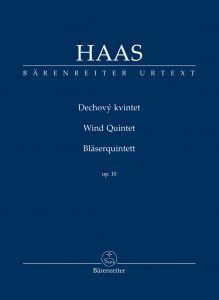 “A bird took off for the sun… flew, flew, and did not arrive…” So wrote Czech composer Pavel Haas (1899-1944) on the draft of his Wind Quintet(1929). If this line is autobiographical, then Haas’s birth in Brno is his takeoff. His flight is his early demonstration of composition skill and further development influenced by Moravian folk music, Hebrew chant, study with Janáček, and study of neoclassical and jazz idioms; then his death at Auschwitz was his own prophecy realized.
“A bird took off for the sun… flew, flew, and did not arrive…” So wrote Czech composer Pavel Haas (1899-1944) on the draft of his Wind Quintet(1929). If this line is autobiographical, then Haas’s birth in Brno is his takeoff. His flight is his early demonstration of composition skill and further development influenced by Moravian folk music, Hebrew chant, study with Janáček, and study of neoclassical and jazz idioms; then his death at Auschwitz was his own prophecy realized.
The quintet is about 15 minutes in four movements. “Preludio” is rhythmically advanced with cross-rhythms and tempo modulations in abundance, makes good use of each instrument as leader and in a great variety of instrument pairings, and has a fortissimo ending. The chromatic, stepwise primary motive is from an earlier song, Černý les (Black Forest). Low register, solo flute begins “Preghiera” (Prayer) with an oscillating minor third melody of an improvisatory character. Central to the movement is the clarinet’s elaboration of the flute melody culminating in a three-measure cadenza. Just as in the first movement, the horn has its share of melodic lead, dramatically playing to high C. “Ballo eccentrico” resounds with folk dance, and like Hindemith in his Quintett für Klarinette und Streichquartett, Op. 30 (first version 1923) and Janáček in his Concertino (1925), Haas asks the clarinetist to pick up an E-flat clarinet for its syncopated romp. This good humor is reinforced by piccolo in place of flute and two sections played vivace. The 66-bar “Epilogo” does bring it all together with soloistic use of each instrument, contrasting tempos and instrument pairings, chant-like and folk-like melody, multiple meters, and with the robust conclusion, a solid sense of purpose.
Editor Robert Simon provides an insightful preface, and in his critical report details the sources and specific editorial problems (including an issue with the E-flat clarinet part), and identifies many small inconsistencies from the 1935 printed score with autograph corrections. This wonderful quintet is highly recommended for advanced ensembles with an eagerness to engage with an important historic composer.
– Gregory Barrett
Luigi Bassi. Konzertfantasie on themes from the opera Rigoletto of Giuseppe Verdi. Arranged by Nicolai Pfeffer for clarinet and string orchestra. Trio Musik Edition, Clarinova Series, 2020. Score €23.50, parts €5.30–€7.80
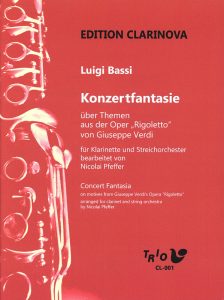 Nineteenth-century Italy had a predominance of opera composers, and from their operas many arrangements for various instrumental combinations were made. The clarinet as solo voice was often used. We have many dozens of arrangements of arias from the most celebrated (and less famous) operas of the golden age of Italian melodrama. Many Italian virtuoso clarinetists composed arrangements of that kind; for instance: Carulli, Bassi, Cavallini, Sebastiani, Mirco, Salieri, Della Giacoma, and many others. Luigi Bassi (1833-1871) was a pupil of B. Carulli (who also taught the great E. Cavallini) and then principal clarinet at La Scala. He also played at Teatro Carcano and Teatro della Canobbiana of Milan. He was praised by the well-known conductor and pianist Hans von Bülow as “valentissimo artista.” Bassi left a good number of clarinet compositions including some didactic works, opera arrangements, clarinet duos, and even a clarinet concerto, not published yet. His Rigoletto Fantasy is one of the most performed clarinet opera fantasies nowadays. It was premiered at Teatro Re of Milan on February 26, 1867. Nicolai Pfeffer offers us another fine publication from Clarinova using the Bassi version arranged to be performed with a string orchestra (or string quartet plus double bass). This is a very good opportunity for clarinetists to have a soft, mellow carpet in the accompaniment, while singing wonderful arias from Verdi’s Rigoletto and while showing off all the virtuoso elements. Thanks Nicolai, good job once again!
Nineteenth-century Italy had a predominance of opera composers, and from their operas many arrangements for various instrumental combinations were made. The clarinet as solo voice was often used. We have many dozens of arrangements of arias from the most celebrated (and less famous) operas of the golden age of Italian melodrama. Many Italian virtuoso clarinetists composed arrangements of that kind; for instance: Carulli, Bassi, Cavallini, Sebastiani, Mirco, Salieri, Della Giacoma, and many others. Luigi Bassi (1833-1871) was a pupil of B. Carulli (who also taught the great E. Cavallini) and then principal clarinet at La Scala. He also played at Teatro Carcano and Teatro della Canobbiana of Milan. He was praised by the well-known conductor and pianist Hans von Bülow as “valentissimo artista.” Bassi left a good number of clarinet compositions including some didactic works, opera arrangements, clarinet duos, and even a clarinet concerto, not published yet. His Rigoletto Fantasy is one of the most performed clarinet opera fantasies nowadays. It was premiered at Teatro Re of Milan on February 26, 1867. Nicolai Pfeffer offers us another fine publication from Clarinova using the Bassi version arranged to be performed with a string orchestra (or string quartet plus double bass). This is a very good opportunity for clarinetists to have a soft, mellow carpet in the accompaniment, while singing wonderful arias from Verdi’s Rigoletto and while showing off all the virtuoso elements. Thanks Nicolai, good job once again!
– Luigi Magistrelli
Russ Peterson. Gypsy Concerto: Concerto for Clarinet and Orchestra. Russellpeterson.com, 2021. Clarinet with piano reduction download, $35.00; full orchestral score and parts download, $150, russpeterson.gumroad.com
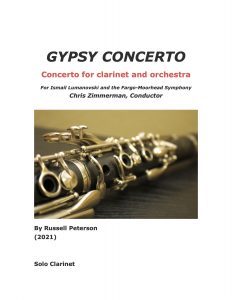 Written for Ismail Lumanovski and the Fargo-Moorhead Symphony with conductor Christopher Zimmerman, Russ Peterson’s Gypsy Concerto is scored for solo clarinet and full orchestra, plus soprano saxophone, piano, drum set, and electric bass. As its title implies, the piece follows a long tradition of works that incorporate musical exoticism, or the referencing of musical traditions outside of that of the home musical culture. In this case, the primary outside tradition is that of the Romany people, also known as Roma or “gypsies,” although additional traditions are also incorporated.
Written for Ismail Lumanovski and the Fargo-Moorhead Symphony with conductor Christopher Zimmerman, Russ Peterson’s Gypsy Concerto is scored for solo clarinet and full orchestra, plus soprano saxophone, piano, drum set, and electric bass. As its title implies, the piece follows a long tradition of works that incorporate musical exoticism, or the referencing of musical traditions outside of that of the home musical culture. In this case, the primary outside tradition is that of the Romany people, also known as Roma or “gypsies,” although additional traditions are also incorporated.
The 15-minute work is in one movement, with multiple sections, specifically titled Moderato, Lento, Largo, Moderato, Largo, and Allegro. The last includes instructions to become increasingly faster in each of several subsections. There are also two cadenzas among the sections. For the first, the soloist may choose to improvise a new solo or to play the notated solo created by the dedicatee. By contrast, the second cadenza is written out. Several other instruments, such as the flute, oboe, English horn, bassoon, horn, violin, cello, electric bass, and piano also have solo lines at various points in the work.
As is typical of pieces striving to allude to the music of the Romany people, the concerto incorporates a number of particular stylistic tropes. These tropes include quasi-rhapsodic or improvisatory-sounding melodies, abundant augmented seconds, frequent octave leaps, chromatic passages, and the double harmonic minor scale, which is to say, a seemingly major scale with flatted second and sixth scale degrees. Indeed, much of the solo clarinet line involves running up and down the double harmonic minor scale in complex rhythmic permutations, somewhat emulating rhapsodic improvisation.
Other influences are apparent as well. For example, the work at times sounds reminiscent of klezmer. This is not surprising, given that the Romany and klezmer traditions were closely intermingled at various instances in their respective histories, and the clarinet is frequently a featured instrument in klezmer. Moreover, the piece lends itself to ad lib vibrato, ornamentation, and pitch bending, all of which are commonplace in both Romany and klezmer music. The trio of elements are indeed heard on the premiere performance recording of the work, found on YouTube. There are also hints of elements typical of jazz, particularly in the syncopated rhythmic structures and the complex harmonies of the piece. Finally, there is a brief hand drum solo in the Allegro section of the work that may allude to West African drumming traditions. These elements are in addition to periodic lush romantic segments for the string sections and dramatic moments for the brass, sprinkled throughout.
As a virtuosic showpiece for the clarinet, the work features numerous challenging elements for the solo instrument. Beyond the aforementioned rhapsodic passages and application of the double harmonic minor scale, these comprise several tempo changes: a segment in 7/8, and a passage in 9/8 with a 2+2+2+3 feel. The work also frequently ventures well into the upper altissimo register of the clarinet. Thus, the solo line clearly requires a capable and advanced player.
For a clarinetist looking for a new concerto that is contemporary and demanding, yet accessible and light, Peterson’s colorful offering is quite worthy of consideration.
– Lacey Golaszewski
Comments are closed.